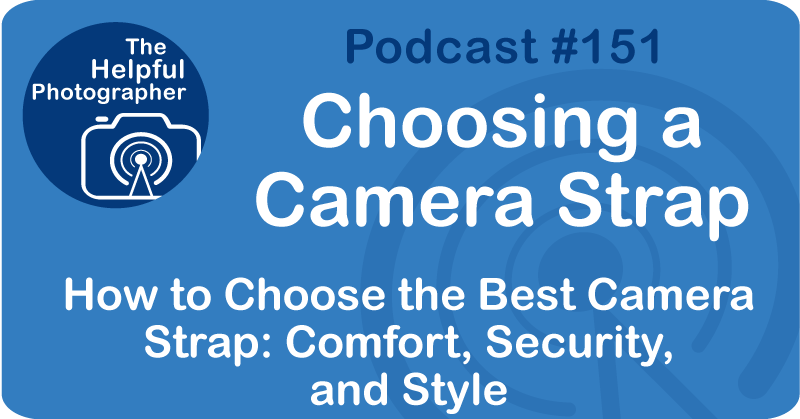Choosing a Camera Strap #151

Lately, I've been getting lots of questions about camera straps. So that's today's topic. If you spend any time walking around with a camera, you know how important a good camera strap can be. It's one of those pieces of equipment you don't really think about until you don't have it. Or worse, until it starts causing you problems. Since the beginning of handheld cameras, the neck strap was all we had. And it didn't suck because we didn't know any better. Then along came a company called Black Rapid.They changed the whole thing with something they called the sling strap. I remember the first time I saw it. I thought, wow, someone finally improved the neck strap. Within a couple of weeks, I had my own and I never looked back. I have even bought them as gifts for friends. Unfortunately, I recently lost my Black Rapid strap. Don't ask me how. So I had to buy a new one, which got me thinking about camera straps all over again.
Let's talk about the options out there, what works, what doesn't, and what you should consider when buying a strap. First, let's break it down. The sling strap: unlike the neck strap, the sling strap goes diagonally across your body, which makes carrying the camera way more comfortable. The camera slides up and down the strap smoothly when you need to take a shot. Now, the fact is, if you have a long enough neck strap, you can wear that as a sling. It's not as comfortable as one that was built to do that, but you can do it. There are plenty of brands making sling straps now, with tons of knockoffs too because Black Rapid's original patent has expired. But not all sling straps are created equal. I tried a cheaper knockoff when I replaced my lost strap two months ago, and honestly, it just didn't measure up. When you're choosing a strap, be sure to look at the various plastic or metal components of the strap. The key is it comes down to the little design features. Usually, the cheap knockoffs use cheaper parts, and those cheaper parts actually make a difference, even though they're small. Well-made straps have sleeker, more compact components that usually work very well.
When you're considering camera straps, another key thing to think about is the connection point. Most sling straps attach to the bottom of the camera where you'd usually screw in a tripod plate with a thumb screw or something similar. Although this works just fine, for me, this is a huge problem because it means that I have to remove the device in order to attach the tripod plate so I can get into my tripod or monopod. It's slow and a pain if you're constantly moving between handheld and tripod shots, which I do at least a few times a day when I'm working.
Fortunately, there are manufacturers that offer quick solutions for this. Some brands, like Fusion Plate Gear, make plates that allow you to connect your strap directly to the tripod quick-release plate so you can get in and out of your strap quickly. It's a fantastic workaround. So even thought I need another device to make my Black Rapid more efficient, it really works great. So as you decide on a strap, pay attention to the connection point.
The width of the strap is all about comfort. Straps generally range from about an inch to two inches wide. Personally, I prefer a narrower strap with a padded area where it sits on my shoulder rather than one that's two inches wide all the way through. But this is really a personal choice. I know a lot of people who love the two-inch wide strap—it's just not for me.
A lot of straps also have an anti-theft component, where the straps are reinforced with a metal wire to prevent them from being easily cut. At first, I thought this was a gimmick. Because I thought, it can't be that easy to cut one of these straps. But after I put a razor blade against regular webbing, I realized how quickly you can slice through it. It was like cutting butter. So if you're worried about theft, this could be a great feature to consider.
Another type of support is the chest mount system, which involves a harness that goes over your shoulder and a plate that sits on your chest to attach your camera. It might sound odd, but trust me, it's surprisingly comfortable, especially with heavy lenses. I've used it while birding with my 150-600mm lens, and it's a lifesaver for managing weight and lens changes.
Here's the scenario: I'm shooting with my 150-600mm lens but need to switch to a smaller lens like my 70-200. Storing the big lens in my bag is cumbersome and slow to get to. With the chest mount system, I can quickly detach the camera, store the larger lens on my chest via the tripod collar, and grab the smaller lens from my bag. When I need to switch, I take off the smaller lense, and i easily and quickly drop it in my bag and then attach the lens that's on my chest. I can also walk around with the camera on my chest, keeping my heads free for trekking poles, grabbing a sip of water or simply for stability when i'm climbing over rocks. The weight distribution is excellent although there's still an issue with the mounting, which can again complicate the use of a tripod or monopod. THere are workarounds but they're often pricey.
Aside from straps, let’s not forget about the **holster systems**. These are popular with wedding photographers and allow you to carry your camera on your waist, freeing up your hands. It’s a great way to distribute the weight, but still keeps the camera accessible. These systems consist of two parts: a locking mechanism attached to your belt and a plate that connects to your camera’s tripod mount. Some holster systems like are Arca-Swiss or RC2 compatible, but others require removing the plate with a hex key before attaching the camera to a tripod. Those tend to be rather heavy. Another handy feature is the ability to attach the locking mechanism to a backpack’s shoulder strap, which is fantastic for hiking. It takes the weight off your neck and makes walking much more comfortable. However, if you have a big camera setup, these can feel cumbersome—but keep in mind, I’m 5’4”, so your experience might be a bit different.
I must say that I really do like having my camera on my waist and I’ve found a simple, budget-friendly solution. I use a $3 key clip on my belt to hook my sling strap. This shifts the weight to my hip, relieving strain on my shoulders while keeping the camera accessible. The last strap I want to mention is the Pi Sport strap made by Silence Corner. This versatile strap hasn’t gotten much attention in the blogosphere, and I’m not sure why, but it addresses many issues photographers face with traditional straps. The Pi Sport strap features a quick-release system that’s Arca-Swiss compatible and can transform into a neck strap, sling strap, chest-mount system, or even a hip holster. Yes, it does all of that! And it’s not any heavier than any of the other systems that I’ve mentioned. When I’m hiking and need to use trekking poles or climbing over rocks to get to waterfall or something like that, I can convert it to a chest mount system where it stays out of the way but remains accessible for quick shots.
For city shooting where I’m not carrying a camera bag, I can wear it as a hip holster. This flexibility is a game-changer for me. However. I did find that I had to add a J hook and a two sided carabiner to the strap to make it easier to use as a holster. The J hook allows me to get in and out of the strap quickly and the two sided carabiner holds the two ends of the strap to together because I have a small waist. Full disclosure: I’m a NISI dealer, and Silence Corner is a NISI brand. But I really do love this strap for how well it adapts to various shooting situations even more than my Black Rapid
Before I finish today I want to switch gears and talk about hand straps. Mostly, I see men using these. My assumption is that it's mostly men because they have larger hands. One version is a simple leash that wraps around your wrist, and is really just meant to preventi you from dropping your camera altogether in case you get bumped or something. The strap doesn’t offer any kind of support so even with a small camera, I think having your camera dangle off your wrist or holding it in your hand all day can get exhausting, even with a small camera. Aside from the wrist strap, there’s also a version that makes your camera feel more like a glove. One attaches to the shoulder strap loop on the top right side of your camera and the other attaches to the tripod mount at the bottom of the camera and it’s meant to keep the palm of your hand snug to the camera grip. I’ve tried it, and I had a love hate relationship with these. While I was actively shooting this was great. But if I needed to do anything else I hated it because I had to kinda yank my hand out of the system. And walking around with my camera just next to me, even for short periods of time, just didn’t feel right. But if you have stronger and bigger hands, it might really work for you. And I do know men who absolutely love these.
Whether you're shooting in the city or trekking through the wilderness, the right support system can make a huge difference in comfort and efficiency. My recommendation: head to a camera store and try them out before you buy. If you've tried any of these systems or have questions, I'd love to hear about it. Send me an email at [email protected].











